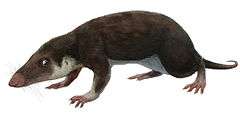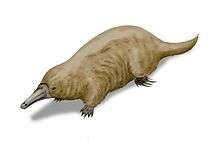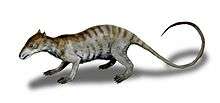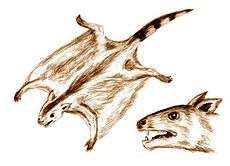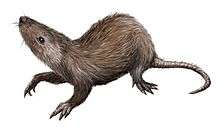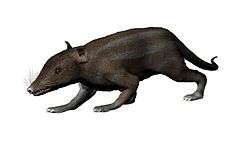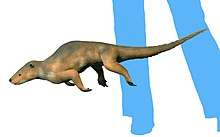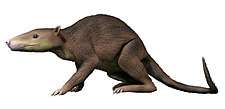Asiatheriidae
Asiatheriidae ("Asian opossums") is an family of Cretaceous metatherians in the order Asiadelphia. Different from the Ameridelphia, they lacked a prominent distolateral process on the scaphoid, and possessed a more slender fibula. The masseteric fossa is deeper in this group than the true marsupials.
| Asiatheriidae | |
|---|---|
.jpg) | |
| Scientific classification | |
| Kingdom: | Animalia |
| Phylum: | Chordata |
| Class: | Mammalia |
| Order: | †Asiadelphia |
| Family: | †Asiatheriidae Trofimov and Szalay, 1994 |
| Genera | |
| |
Further reading
Zofia Kielan-Jaworowska, Richard L. Cifelli, and Zhe-Xi Luo, Mammals from the Age of Dinosaurs: Origins, Evolution, and Structure (New York: Columbia University Press, 2004), 15, 451–452.
| ||||||||||||||||||||||||||||||||||||||||||||||||||||||||||||||||||||||||||||||||||||||||||||||||||||||
| ||||||||||||||||||||||||||||||||||||||||||||||||||||||||||||||||||||||||||||||||||||||||||||||||||||||
| ||||||||||||||||||||||||||||||||||||||||||||||||||||||||||||||||||||||||||||||||||||||||||||||||||||||
| ||||||||||||||||||||||||||||||||||||||||||||||||||||||||||||||||||||||||||||||||||||||||||||||||||||||
| ||||||||||||||||||||||||||||||||||||||||||||||||||||||||||||||||||||||||||||||||||||||||||||||||||||||
| ||||||||||||||||||||||||||||||||||||||||||||||||||||||||||||||||||||||||||||||||||||||||||||||||||||||
| ||||||||||||||||||||||||||||||||||||||||||||||||||||||||||||||||||||||||||||||||||||||||||||||||||||||
| ||||||||||||||||||||||||||||||||||||||||||||||||||||||||||||||||||||||||||||||||||||||||||||||||||||||
Taxon identifiers | |
|---|---|
| Asiatheriidae | |
| Asiadelphia | |
gollark: Switches, unless they're at stupidly high temperature?
gollark: They could kill the coronavirus by firing relativistic protons at it.
gollark: Star Trek isn't *remotely* realistic, so almost certainly not as they portray it. The closest vaguely plausible thing is probably the Alcubierre drive, which IIRC could maybe exist, isn't remotely practical, and comes with its own exciting problems.
gollark: They can't be conveniently converted to metres or... anything, really, and don't work with SI prefixes.
gollark: Miles are still an awful unit even if you're used to them.
This article is issued from Wikipedia. The text is licensed under Creative Commons - Attribution - Sharealike. Additional terms may apply for the media files.
